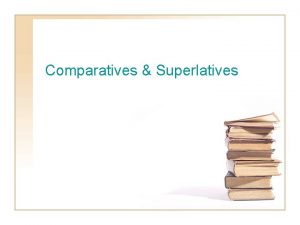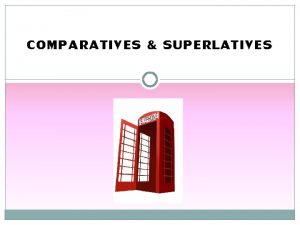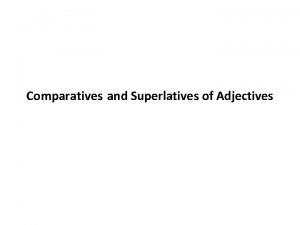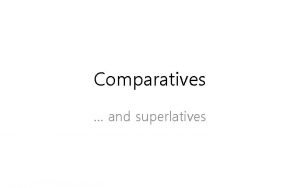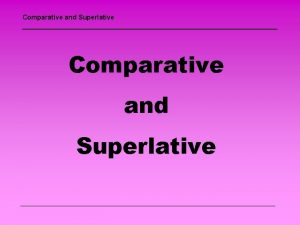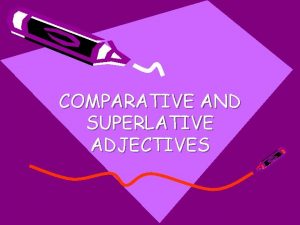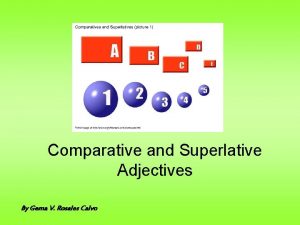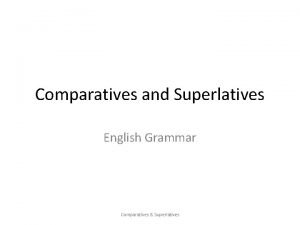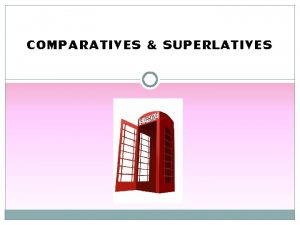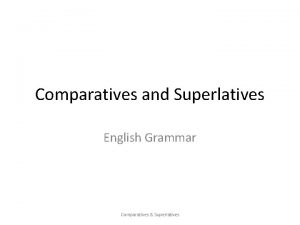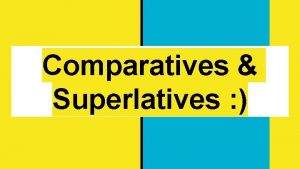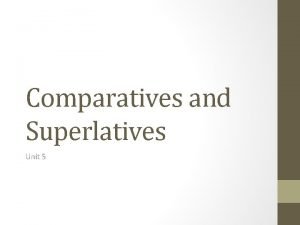Comparatives and Superlatives Unit 5 Comparatives We use










- Slides: 10

Comparatives and Superlatives Unit 5

Comparatives We use comparatives to compare two things, two animals or two people. She is taller than her husband North Pole is colder than Sardinia My dog is bigger than yours

Form: To form both comparatives and superlatives you need to know the number of syllables in the adjective. Syllables are like "sound beats“ and you count them according to the pronunciation of each word. For instance: "find" contains one syllable, "finding" contains two syllables (find and ing) ing "magazine" contains three syllables, beacuse we read it /maga'zi: n/ Watch this video: https: //www. youtube. com/watch? v=o. PNAYXxx. RUs

COMPARATIVES One-syllable and two-syllable adjectives To form the comparative of one-syllable adjectives you add –er to –er the base form of the adjective: Cheap cheaper Fast faster Tall taller Spelling rules: Spelling rules a) One syllable adjective ending in a silent 'e‘ add just r nicer b) if the adjective ends in –y preceded by a consonant –y changes into -i before adding –er funny funnier c) One syllable adjectives ending in one vowel and one consonant double the final consonant before adding –er bigger

To form the comparative of two or more syllable adjectives you add more before the adjective: more exciting than more interesting than more dangerous than more boring than We use than to introduce the second term of the comparison Tom is stronger than Peter is weaker than Tom


Superlatives are used to show the difference between more than two things or more than two people. e. g Paris is the biggest city in France The rules to form superlatives are the same as for comparatives. Instead of –er you add –est and put the definite article «the» before the adjective. Spelling rules: rules 1. One syllable adjective ending in a silent 'e‘ add just –st nice the nicest 2. Adjectives ending in –y preceded by a consonant change –y into -i and add –est funny the funniest 3. One syllable adjectives ending in one vowel and one consonant double the final consonant before adding –est: big the biggest

Compare…

To summarize… Comparatives Superlatives Comparatives are used to compare two things or two people: Alan is taller than John. Superlative adjectives are used to describe an object which is at the upper or lower limit of a quality (the tallest, the smallest, the fastest, the highest). They are used in sentences where a subject is compared to a group of objects. Superlative sentences usually use 'the': Alan is the most intelligent. Similarities To express similarities use the following structure: …. as + adjective + as…. as • Mike is as intelligent as Nancy. • Larry is as popular as Oprah.

Irregular comparatives and superlatives Adjectives Comparatives Superlatives bad worse worst far(distance) farther farthest far(extent) further furthest good better best little less least many more most much more most
 Comparative diligent
Comparative diligent Comparatives and superlatives warm
Comparatives and superlatives warm Busycomparative and superlative
Busycomparative and superlative Optimistic comparative and superlative
Optimistic comparative and superlative Superlative of danger
Superlative of danger Comparative forms of adjectives review
Comparative forms of adjectives review Fat superlative and comparative
Fat superlative and comparative Tidy comparative and superlative
Tidy comparative and superlative Bad in the comparative form
Bad in the comparative form Comperative of well
Comperative of well Handsome comparative adjective
Handsome comparative adjective

